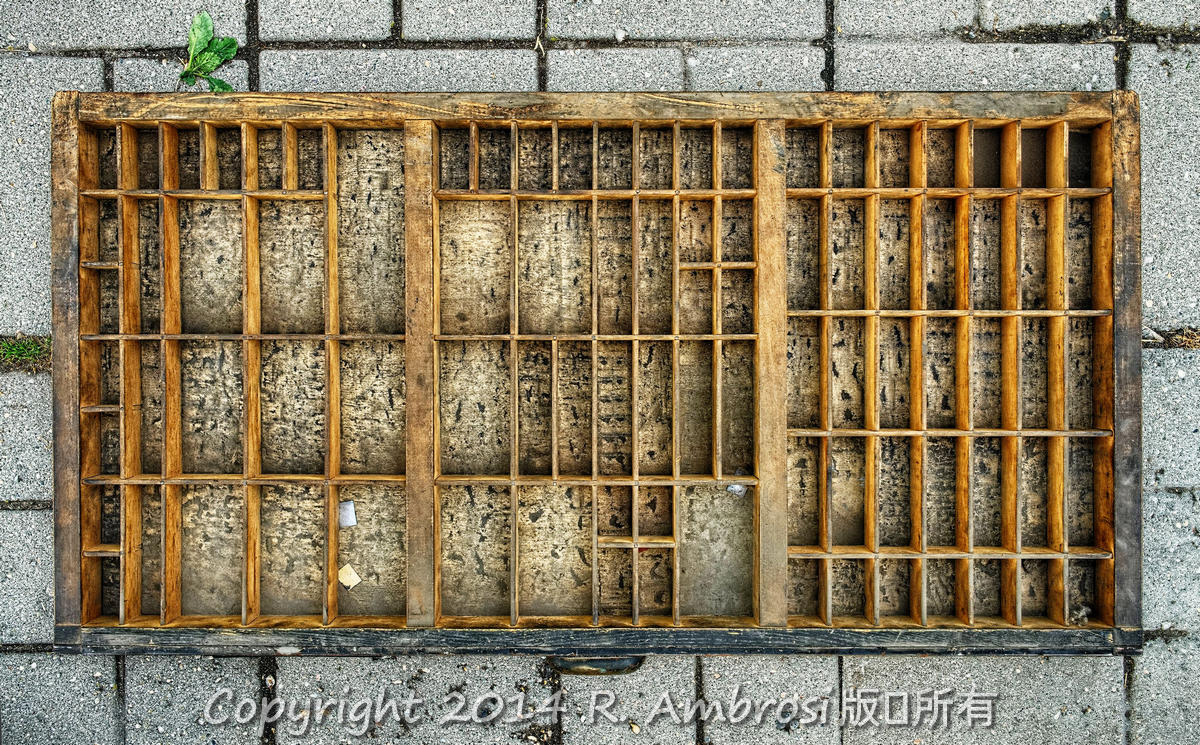
Example #2. California Case. The cases differ slightly in appearance. We have not washed or cleaned them other than to blow out the dust. There are slightly different patinas on the wood. Expect the case you receive will look similar to this, but not exact.
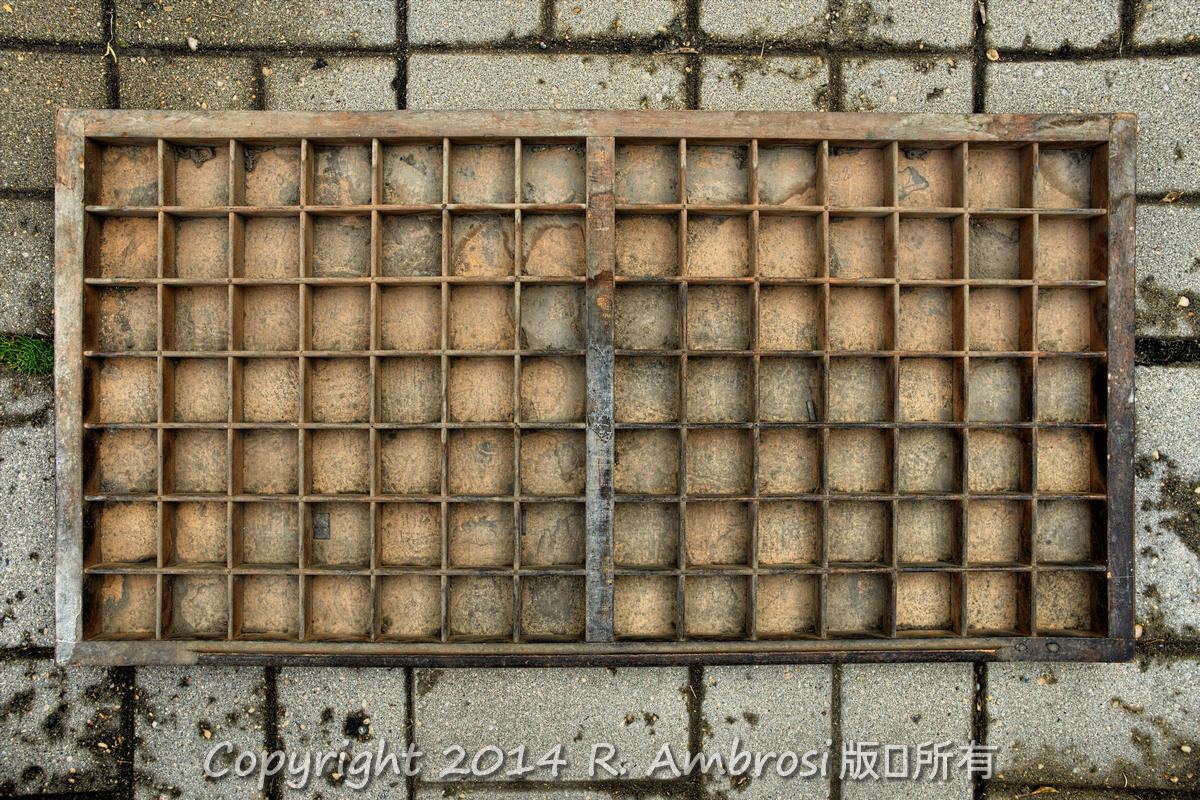
Double Cap Case.
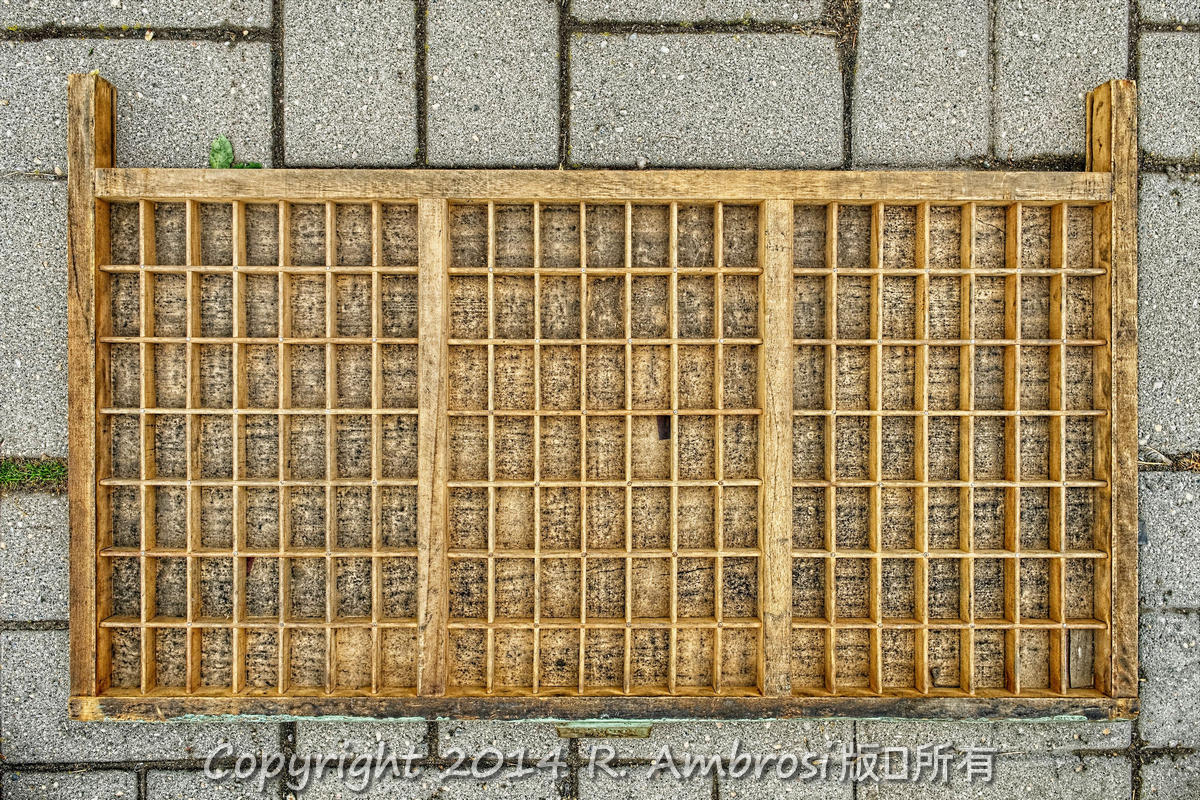
This page describes and includes detailed images of several different types of letterpress type cases. I have written about type cases in a previous article here.
The different varieties of cases include:
|
|
California Cases
The “California Case” is a wooden tray with 89 compartments for storing the movable type used in letterpress printing. The case has 3 sections. The left and center sections hold lower case letter, punctuation marks and numbers. The rightmost section holds capital letters.
While there were many configurations of letterpress type cases, this particular configuration was popularized by San Francisco printers. The layout of the compartments was designed to reduce the distance the compositor’s hand had to travel while selecting individual letters from the case. Capital letters were stored in the upper part of the case while non-capital letters were stored in the lower part of the case. This gave rise to the terms “upper case” to refer to capital letters, and “lower case” to refer to non-capital letters. The most commonly used letters were placed in compartments deems most accessible to the typesetter. The size of each compartment varied according to the frequency that the particular letter was used. For English fonts, the compartment for “e” is the biggest as more “e” type was needed for setting text in English. The “j”, “k”, “q”, “x”, and “z” compartments are the smallest because these letters are used most infrequently.
For more detailed reading, see: http://www.amateurpress.org/bundle/camp194.htm
Prices: $65 each.
Most of these cases are from the 1940s-1950s. They are already more than 60 years old. The wooden joinery and craftsmanship displayed in the construction of these cases is remarkable.
Example #1
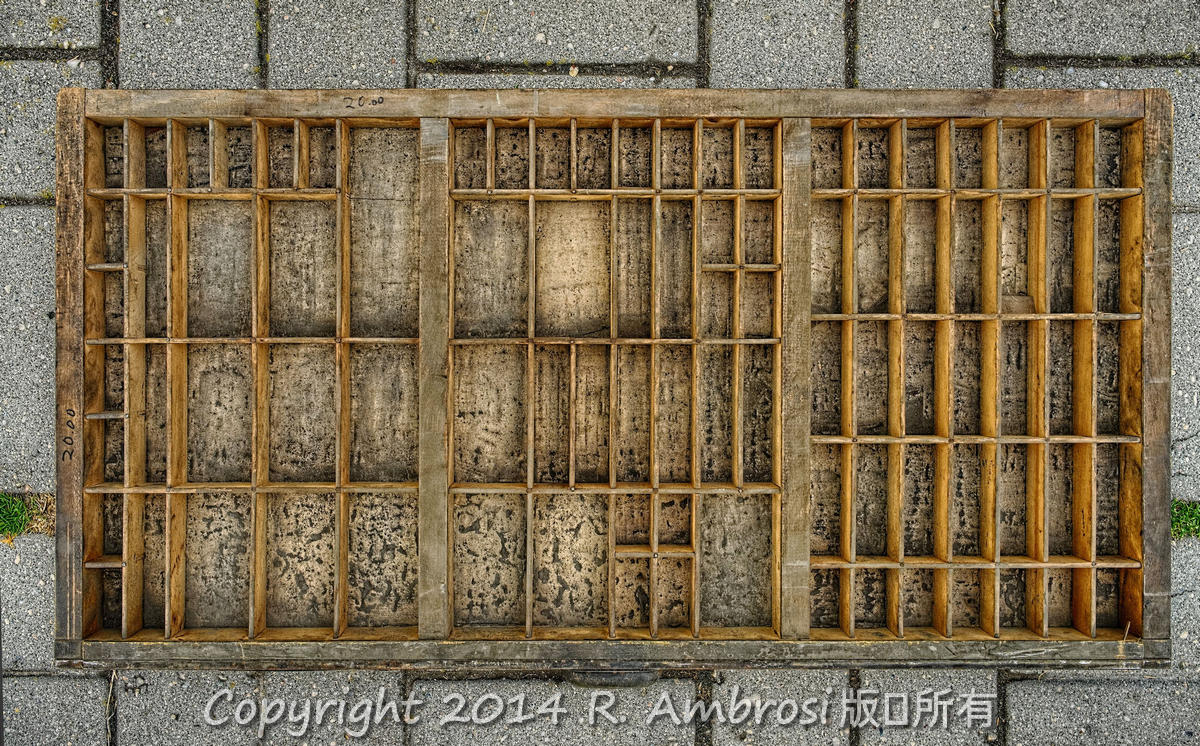 Example #1. California Case. The cases differ slightly in appearance. We have not washed or cleaned them other than to blow out the dust. There are slightly different patinas on the wood. Expect the case you receive will look similar to this, but not exact.
Example #1. California Case. The cases differ slightly in appearance. We have not washed or cleaned them other than to blow out the dust. There are slightly different patinas on the wood. Expect the case you receive will look similar to this, but not exact.
Example #2
 Example #2. California Case. The cases differ slightly in appearance. We have not washed or cleaned them other than to blow out the dust. There are slightly different patinas on the wood. Expect the case you receive will look similar to this, but not exact.
Example #2. California Case. The cases differ slightly in appearance. We have not washed or cleaned them other than to blow out the dust. There are slightly different patinas on the wood. Expect the case you receive will look similar to this, but not exact.
Antique Type Cases
We have several antique type cases acquired over the time we were in business (1929-2014). Each of the three antique cases shown below date to the early 1900s– years before Saskatchewan became a province. Have a look at the Antique Gallery. If you see something you like, don’t hesitate. Type cases this old are not something you come across easily.
These cases are 90-115 years old. These cases probably saw continual use well into the 1970s and the fact they are in such outstanding condition is testimony to the fine workmanship of the craftsmen who built them at the turn of the last century. If you want a less expensive case, check out our standard California cases all of which are at least 60 years old.
Antique Case #1. Price: $375
This antique California Job case dates to at least 1910. A paper label on the back reads “H.C. Stovel & Co. Printers Supplies. Ready Prints, Stereotypers. Winnipeg, Manitoba. To: “The Advocate”, Elkhorn, Manitoba.
“The Advocate” was a small rural newspaper in Elkhorn Manitoba. The company was established in 1892 and ceased operation in 1910, a fact that proves this case was used by “The Advocate” prior to 1910 and more likely dates to the late 1890s.
SPECIAL FEATURES
- dates to the late 1890s.
- has a label on the back listing the name of the newspaper company that owned it allowing its age can be clearly determined.
- features a back made of solid wood boards rather than plywood. The use of solid wood is a clear indicator that the case dates to the 1890s and early 1900s.
- remarkable wooden joinery and craftsmanship.
SIZE
inches 32 inches x 16.5 inches x 1.5 inches
cm 81.5 cm x 42 cm x 4 cm
wide x height x depth
WEIGHT
7 pounds
3.2 kilograms
CONDITION
This case, from the late 1890s, was used in printing shops for sixty or seventy years. It is in very good vintage condition, but there are some scratches and natural age wear that reflect its industrial use over many decades.
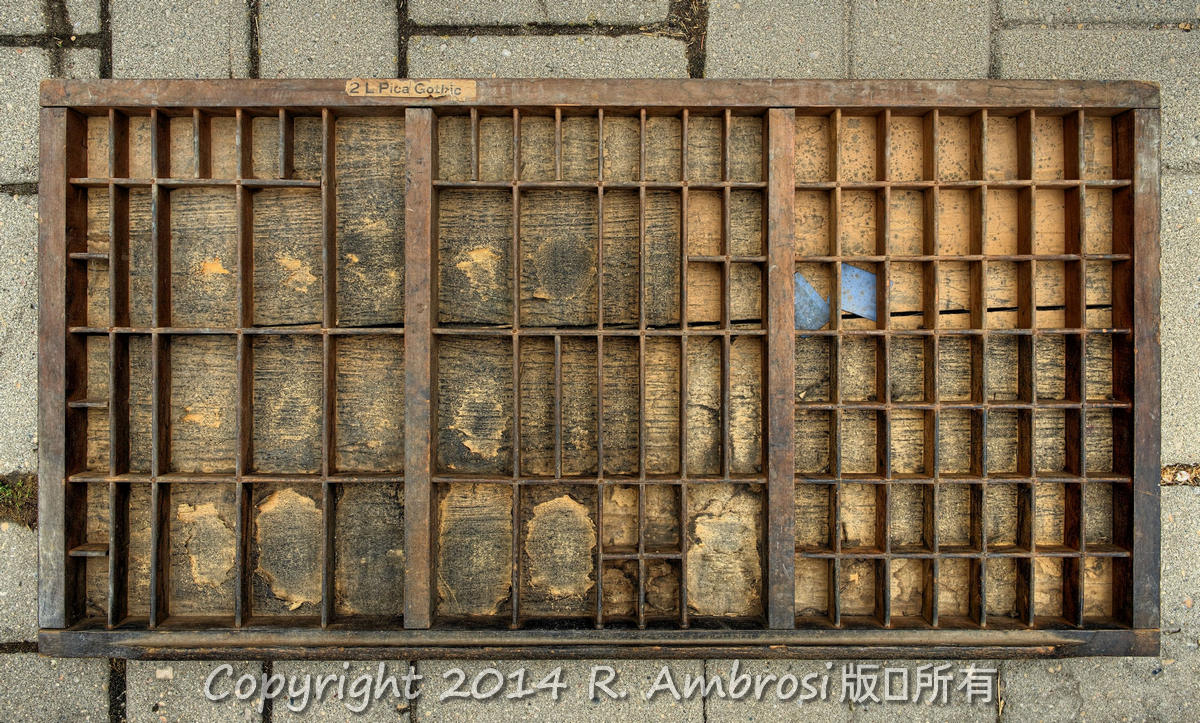 Antique type case dating to pre 1906. Label on the back reads “H.C. Stovel & Co. Printers Supplies. Ready Prints, Stereotypers. Winnipeg, Manitoba. To: “The Advocate”, Elkhorn, Manitoba.
Antique type case dating to pre 1906. Label on the back reads “H.C. Stovel & Co. Printers Supplies. Ready Prints, Stereotypers. Winnipeg, Manitoba. To: “The Advocate”, Elkhorn, Manitoba.
Note: Wikipedia notes that the Advocate was established in 1892 and ceased operation in 1910.
Antique type case dating to pre 1906.
Label reads “H.C. Stovel & Co. Printers Supplies. Ready Prints, Stereotypers. Winnipeg, Manitoba. To: “The Advocate”, Elkhorn, Manitoba.
Note: Wikipedia notes that the Advocate was established in 1892 and ceased operation in 1910. (https://en.wikipedia.org/wiki/Elkhorn,_Manitoba).
Antique type case dating to pre 1906. Label reads “H.C. Stovel & Co. Printers Supplies. Ready Prints, Stereotypers. Winnipeg, Manitoba. To: “The Advocate”, Elkhorn, Manitoba.
Note: Wikipedia notes that the Advocate was established in 1892 and ceased operation in 1910. (https://en.wikipedia.org/wiki/Elkhorn,_Manitoba).
Antique type case dating to pre 1906. Label reads “H.C. Stovel & Co. Printers Supplies. Ready Prints, Stereotypers. Winnipeg, Manitoba. To: “The Advocate”, Elkhorn, Manitoba.
Note: Wikipedia notes that the Advocate was established in 1892 and ceased operation in 1910. (https://en.wikipedia.org/wiki/Elkhorn,_Manitoba).
Antique type case dating to pre 1906. Label reads “H.C. Stovel & Co. Printers Supplies. Ready Prints, Stereotypers. Winnipeg, Manitoba. To: “The Advocate”, Elkhorn, Manitoba.
Note: Wikipedia notes that the Advocate was established in 1892 and ceased operation in 1910. (https://en.wikipedia.org/wiki/Elkhorn,_Manitoba).
Antique type case dating to pre 1906. Closeup showing how the paper backing has been worn through by the typesetters fingers brushing against the bottom of the case over many decades
Antique type case dating to pre 1906. Closeup of the joinery
Antique type case dating to pre 1906. Closeup showing how the paper backing has been worn through by the typesetters fingers brushing against the bottom of the case over many decades
Antique Case #2. Price: $300
This antique Two-Thirds case can be dated to the early 1900s. On the back of the case is a stencil “American Type Founders Company. Winnipeg, Can. 6972, 4”. The number “6972” on the back is the serial number indicating that it is the 6972th case manufactured by the company. The “4” indicates that this case was part of a lot of four cases that had been shipped to a customer by the American Type Founders Co.
SPECIAL FEATURES
- Two-Thirds Double Lower Case type case. A rather rare configuration.
- dates to the early 1900s.
- has a stenciled stamp on the back side on the back listing “American Type Founders Company. Winnipeg, Can”.
- the serial number 6972 indicates it was one of the early cases produced by American Type Founders.
- case has a thin plywood backing that dates to the early 1900s. The industrial production and use of plywood began in the USA shortly after it was from France in 1865 and by 1907, the production of plywood increased dramatically. (Sources: https://en.wikipedia.org/wiki/Plywood#cite_ref-3; http://www.apawood.org/apas-history).
- many compartments are labeled with pencil marks indicating the character that was sorted in that particular compartment. These pencil notations were made many decades ago by apprentice printers as they memorized the case order.
- remarkable wooden joinery and craftsmanship.
SIZE
inches 21.5 inches x 16.5 inches x 1.5 inches
cm 55.5 cm x 42 cm x 4 cm
wide x height x depth
WEIGHT
6 pounds
2.7 kilograms
CONDITION
This case was likely made prior to 1910 and was used in printing shops for sixty or seventy years. It is in very good vintage condition, but there are some scratches and natural age wear that reflect its industrial use over many decades.
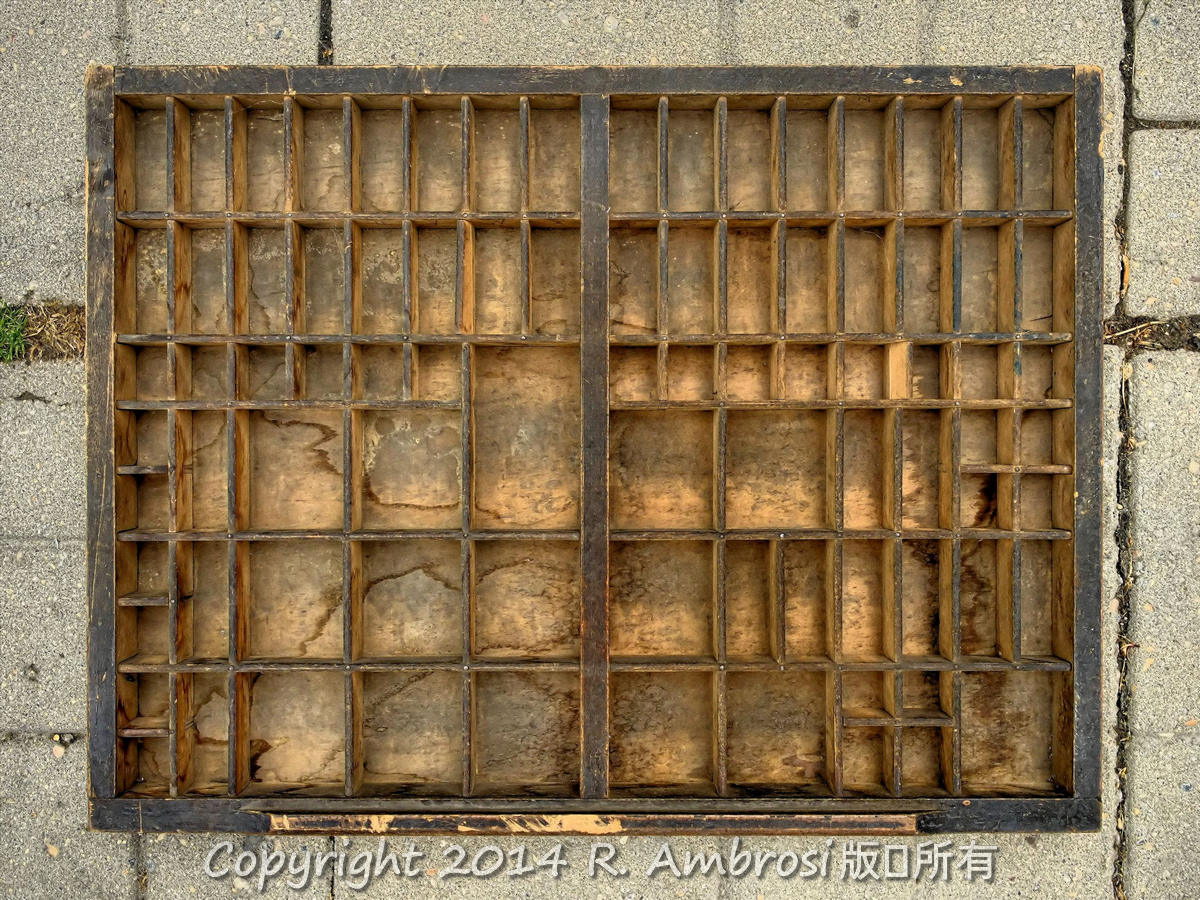 Antique Case #2. Two-Thirds case. Circa early 1900s
Antique Case #2. Two-Thirds case. Circa early 1900s
Antique Case #2. California case. Circa early 1900s Closeup of compartments.
Antique case #2. Back of case.
Antique case #2. Closeup of the compartments.
Antique Case #2. California case. Circa early 1900s
Antique Case #3. Price: $500
This Double Cap Case can be conclusively dated to at least 1905. This case is a rare find indeed: the writing on the back side of the case allows us to clearly identify its owner and history.
The inscription clearly shows us that: J. Scott purchased the Whitewood Herald in 1900 acquiring some of the equipment from the previous owner. This case was purchased new from a manufacturer who addressed Scott’s name, town, and district on the back of the case prior to shipping. The abbreviation “Assn” stands for “The District of Assiniboia“, an administrative region that was later incorporated into the province of Saskatchewan in 1905. The writing on the case indicates the case was in use by J. Scott prior to the establishment of the province of Saskatchewan in 1905.
SPECIAL FEATURES
- Double Case type cases were far less common than California cases and thus are harder to find.
- 98 equally sized compartments each of which is 2 inches x 2 inches
(5.1 cm x 5.1 cm) - the inscription on the back of the case identifies the owner, location, and age of the case. It can be clearly dated to the early 1900s and could date to as early as the 1880s.
- case has a thin plywood backing that dates to the early 1900s. The industrial production and use of plywood began in the USA shortly after it was from France in 1865 and by 1907, the production of plywood increased dramatically. (Sources: https://en.wikipedia.org/wiki/Plywood#cite_ref-3; http://www.apawood.org/apas-history).
- many compartments are labeled with pencil marks indicating the character that was sorted in that particular compartment. These pencil notations were made many decades ago by apprentice printers as they memorized the case order.
- remarkable wooden joinery and craftsmanship.
SIZE
inches 32 inches x 16.5 inches x 1.5 inches
cm 81.5 cm x 42 cm x 4 cm
wide x height x depth
WEIGHT
7 pounds
3.2 kilograms
CONDITION
This case was manufactured prior to 1905 and was used in printing shops for sixty or seventy years. It is in very good vintage condition, but there are some scratches and natural age wear that reflect its industrial use over many decades.
Antique Double Cap Case.
Antique Double Cap Case. Closeup of workmanship and joinery.
Antique Double Cap Case. Closeup of workmanship and joinery.
Antique Double Cap Case. Closeup of workmanship and joinery.
Double Cap Case
Double Cap cases stored dual sets of capital letters. Because these cases were not needed as often as standard California cases that contained both caps and non-caps, they are considerably rare.
Prices: $90 each.
Most of these cases are from the 1910s-1950s. They are more than 80 years old. The wooden joinery and craftsmanship displayed in the construction of these cases is remarkable. Hard to find, and highly sought after owing to the consistent size of compartments, they are ideal for displaying ornaments, handicrafts and other items.
Double Cap Case
Double Cap Case dating back to at least 1906. The back label “J. Scott, Whitewood, Assn” is the clue. The District of Assiniboia was an administrative region that was later incorporated into the province of Saskatchewan in 190s. The fact the case is labeled as belonging to Mr. Scott in the District of Assiniboia indicates the case was in use prior to the establishment of the province of Saskatchewan in 1905. See https://en.wikipedia.org/wiki/Assiniboia for more information on the District of Assiniboia.
Triple Cap Cases
Triple Cap cases stored three sets of capital letters. Because these cases were not needed as often as standard California cases that contained both caps and non-caps, they are considerably rare.
Prices: $90 each.
Most of these cases are from the 1910s-1950s. They are already more than 70 years old. The wooden joinery and craftsmanship displayed in the construction of these cases is remarkable. Hard to find, and highly sought after owing to the consistent size of compartments, they are ideal for displaying ornaments, handicrafts and other items.
Quad Cases circa 1920s
Hard to find, and highly sought after owing to the consistent size of compartments, these 80 year old Quad Cases are ideal for displaying ornaments, handicrafts and other items. The wooden joinery and craftsmanship of these cases is remarkable. The Quad Case can stand on a table, or hang on the wall. Functioning as a remarkable example of industrial art, it reflects the technology used in letterpress printing industry in the early decades of the last century.
HISTORY
This Quad Case is a wooden drawer with 10 compartments and was used for holding spacing material used in letterpress printing.
The Quad Cases contained spacing material of a size that matched the size of type in the California cases. If a California case in the cabinet had 18 pt font, then the smallest spacing material in the Quad Case was 18 pt (known as a “square”). Larger sizes would be 18pt x 36pt (known as a “double square”) etc.
The numbers that you can see at the top lip of each compartment are likely a form of “shorthand” that differed from shop to shop and referred to the size of the quad stored in the compartment.
The Quad Case was stored as drawers in a regular typesetting cabinet. The location of the Quad Case drawers varied from one cabinet to the next because many different configurations of cabinet existed. However, it was fairly common for the Quad Case drawers to be located in the centre of the cabinet, with a row of California cases to the left and to the right.
The case dates from the 1920s, the heyday of the letterpress printing industry that began to fade in the 1950s with the onset of photo-mechanical lithographic printing technologies. These particular cases were owned by Commercial Printers in Regina, Sask when the company was established in 1929. Commercial Printers received some used printing equipment from the Leader Publishing Company and also purchased new equipment. These cases were acquired by Ambrosi Printers when Commercial Printers closed and was sold off by auction.
Quad cases were used mainly only in larger printing shops that could afford to cast and store large quantities of foundry type in these cases. Smaller shops usually did not have the material resources and capital needed to keep large stocks of quads on hand.
SPECIAL FEATURES
- the tray is more than 90 years old and its vintage condition reflects its role in 19th century printing technology
- precision cast iron handle displays the logo “Hamilton Type Mfg.
- back side features factory drilled mount holes that facilitated mounting on top of a Ludlow cabinet.
SIZE
inches 22.7 inches x 9 inches x 3.5 inches
cm 57.7 cm x 22.7 cm x 8.9 cm
wide x height x depth
each compartment
inches 4″ x 3.5″
cm 10.3 cm x 8.8 cm
WEIGHT
3 pounds
1.3 kilograms
CONDITION
The tray, dating from the 1920s, was used in printing shops for decades. It is in good vintage condition, but there are some scratches and natural age wear that enhances the rustic industrial look.
PRICE: $60
Other cases
Antique Quad Case circa 1920s
Antique Quad Case circa 1920s
Antique Quad Case circa 1920s
Brass Rule Case. Letterpress Printing circa 1920s
Exhibited on a wall or part of an exhibition, this 90 year old Brass Rule Case functions as a remarkable example of industrial art and reflects the technology used in printing industry in the early decades of the last century.
HISTORY
This Ludlow Space and Quads tray is a wooden tray with 18 compartments in the main section and 16 compartments on the side for storing brass rule used for printing horizontal and vertical lines. The case held brass rule in lengths from 1m to 36m. A case of brass rule was an essential item in all printing shops, but especially so for smaller shops that could not afford the expensive Ludlow or Linotype equipment that could cast lead-alloy ruling material.
The case dates from the 1920s, the heyday of the letterpress printing industry that began to fade in the 1950s with the onset of photo-mechanical lithographic printing technologies.
This tray is almost certainly from a rural printing shop in the prairie provinces of Canada and dates from the 1930s. Although the Ludlow Typographic system was popular in Eastern Canada and the USA much earlier, it became common in Western Canada significantly later in the 1930s.
SPECIAL FEATURES
- the tray is more than 70 years old
- exquisite finger joints on each corner
- brass plates on the top edge of compartments prevented wear
- each section of the tray is labeled with brass plates inscribed with “Spaces and Quads”,”High Spaces and Quads”, and “Quad Blocks”.
- this tray is a rare italic version used for storing italic spacing material. Italic trays were far less common than standard trays.
- back side features factory drilled mount holes that facilitated mounting on top of a Ludlow cabinet.
SIZE
inches 15 inches x 7.4 inches x 1 inches
cm 38.3 cm x 18.8 cm x 2.54 cm
wide x height x depth
WEIGHT
1.3 pounds
0.6 kilograms
CONDITION
The tray, dating from the 1920s, was used in printing shops for decades. It is in good vintage condition, but there are some scratches and natural age wear that enhances the rustic industrial look.
PRICE: $60
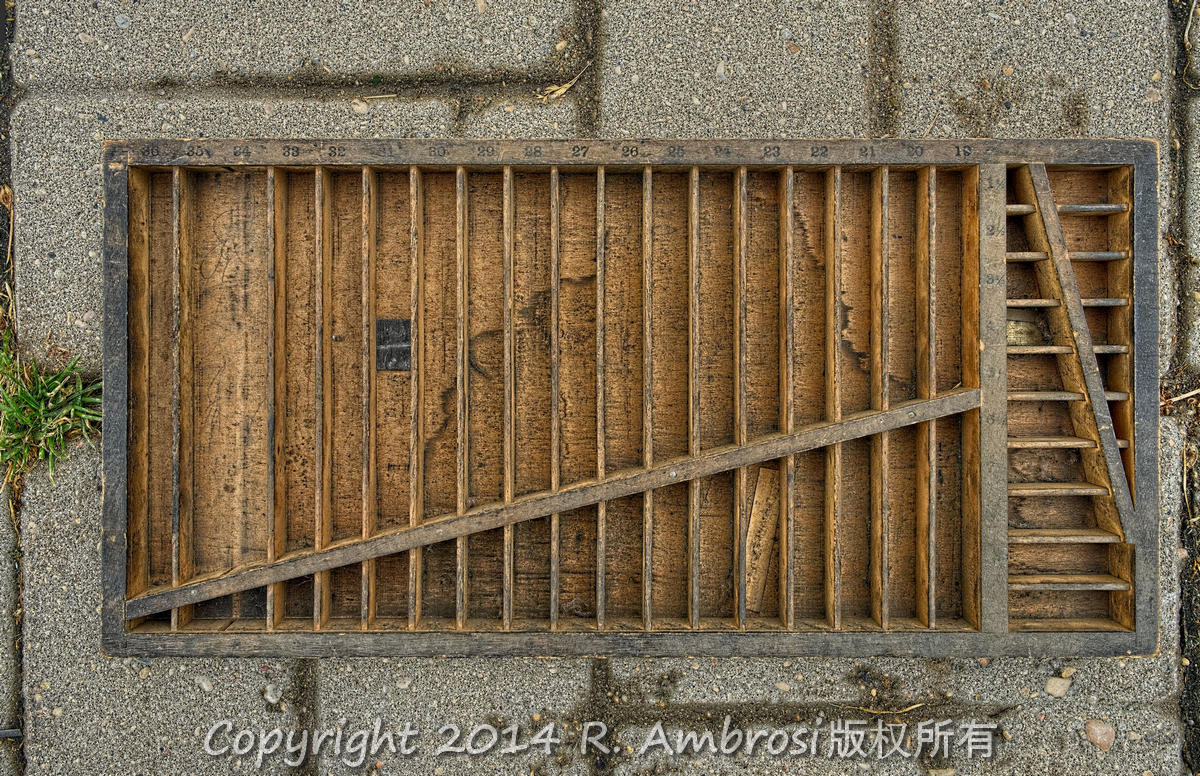
Brass Rule Case juxtaposed against a double cap case to show relative sizes.
Brass Rule Case circa 1920s.
Brass Rule Case circa 1920s. Closeup of the compartments.
Brass Rule Case circa 1920s. Closeup of the compartments.
Brass Rule Case. Letterpress Printing circa 1920s
Ludlow Space and Quads Tray
USES
Storing Ludlow spacing material, miniature collectibles, trinkets, jewelry, heirlooms, souvenirs, photographs, etc.
Exhibited on a wall or part of an exhibition, these antique items are remarkable examples of industrial art, and are testimony to the technology used in newspaper industry in the early decades of the last century.
HISTORY
This Ludlow Space and Quads tray is a wooden tray with 19 compartments for storing Ludlow spacing material used in the letterpress printing industry.
This tray is almost certainly from a rural printing shop in the prairie provinces of Canada and dates from the 1930s. Although the Ludlow Typographic system was popular in Eastern Canada and the USA much earlier, it became common in Western Canada significantly later in the 1930s.
They are already more than 80 years old. The wooden joinery and craftsmanship displayed in the construction of these cases is remarkable.
SPECIAL FEATURES
- the tray is more than 70 years old
- Exquisite finger joints on each corner
- brass plates on the top edge of compartments prevented wear
- each section of the tray is labeled with brass plates inscribed with “Spaces and Quads”,”High Spaces and Quads”, and “Quad Blocks”.
- this tray is a rare italics version used for storing italics spacing material. Italics trays were far less common than standard trays.
- back side features factory drilled mount holes that facilitated mounting on top of a Ludlow cabinet.
SIZE
inches 20 5/8 inches x 6.5 inches x 1.25 inches
cm 52.4 cm x 16.5 cm x 3.2 cm
wide x height x depth
WEIGHT
3 pounds
1.4 kilograms
CONDITION
The tray, dating from the 1920s-1965s, were used in printing shops for decades. They are all in good vintage condition, but there are some scratches and natural age wear that enhances the rustic industrial look.
PRICE: $80
Ludlow Space and Quads Tray. Each section of the tray is labeled with brass plates inscribed with “Spaces and Quads”,”High Spaces and Quads”, and “Quad Blocks”.
Ludlow Space and Quads Tray. Closeup of the precision finger joinery.
Ludlow Space and Quads Tray. Each section of the tray is labeled with brass plates inscribed with “Spaces and Quads”,”High Spaces and Quads”, and “Quad Blocks”.
c
Ludlow Space and Quads Tray
Ludlow Space and Quads Tray. Each section of the tray is labeled with brass plates inscribed with “Spaces and Quads”,”High Spaces and Quads”, and “Quad Blocks”.
Two-Thirds Cases
Two-Thirds Cases- (Coming Soon). Because these cases were not needed as often as standard California cases, they are considerably rare.
Prices: $75 each.
These cases are from the 1920s-1940s and are more thcan 70 years old. The wooden joinery and craftsmanship of these cases is remarkable. Hard to find, and highly sought after owing to the consistent size of compartments, Two-Thirds cases are ideal for displaying ornaments, handicrafts and other items.



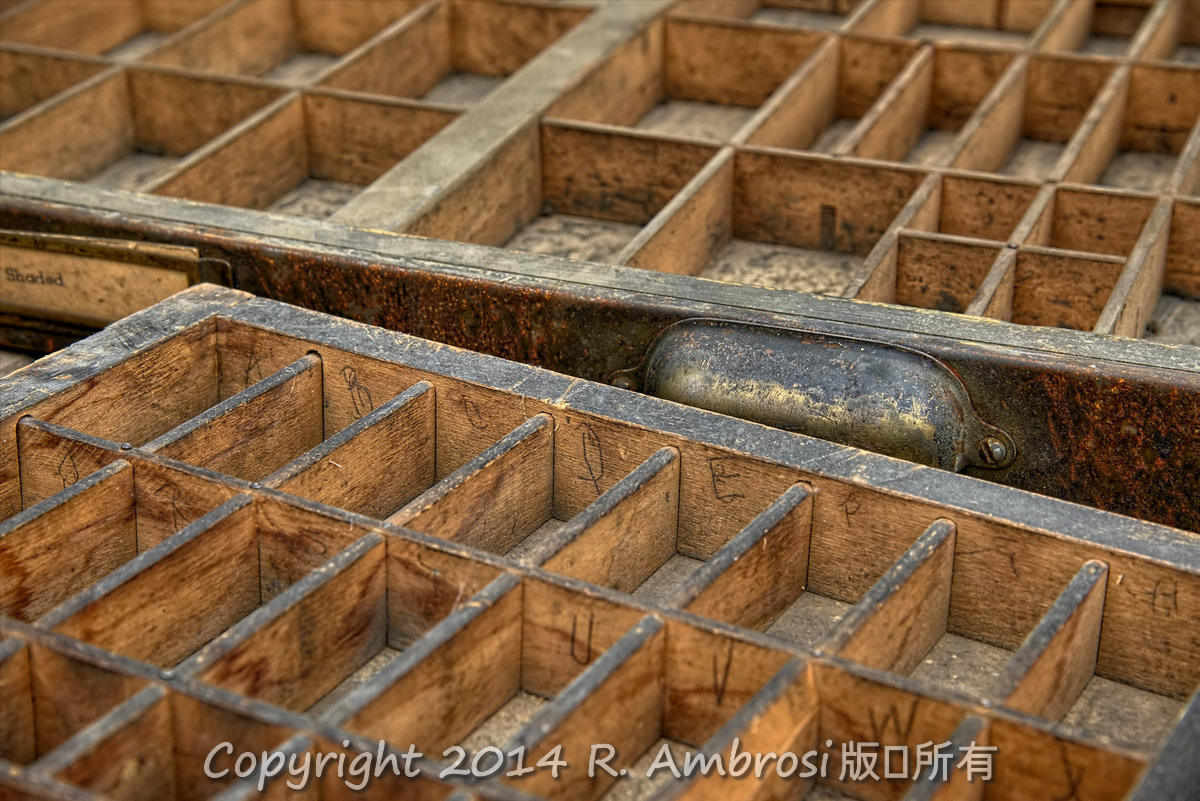
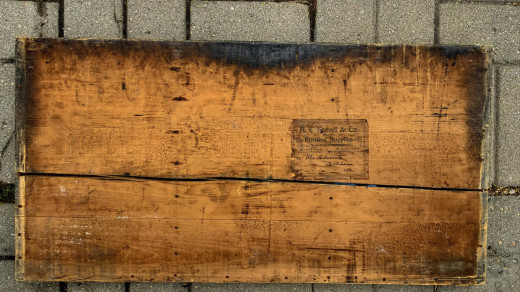
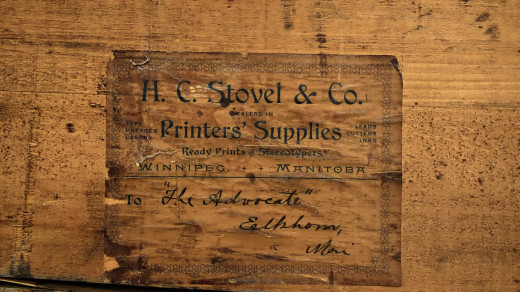
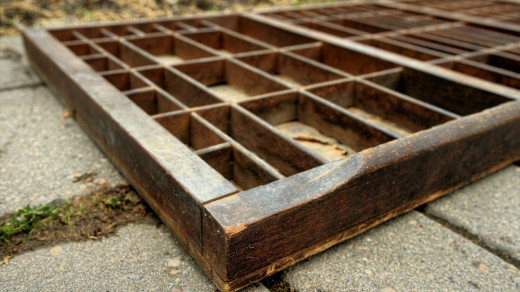
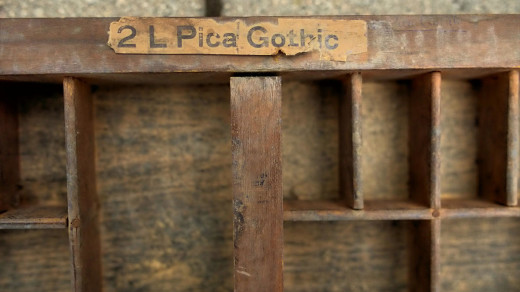
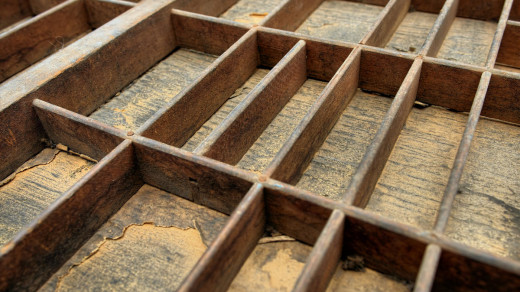
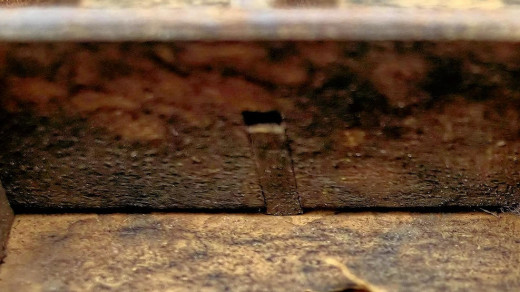
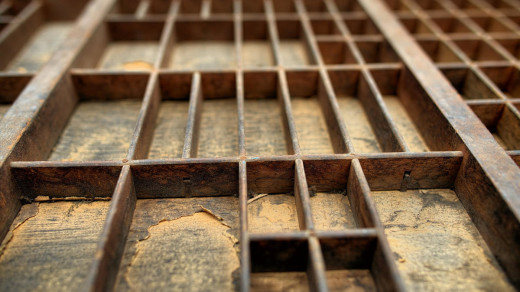
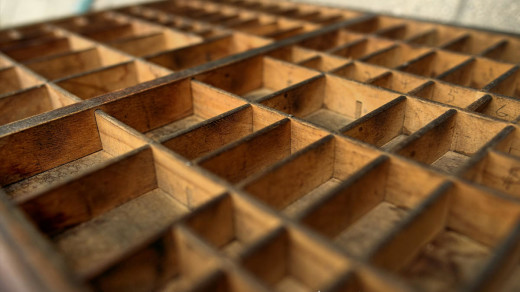
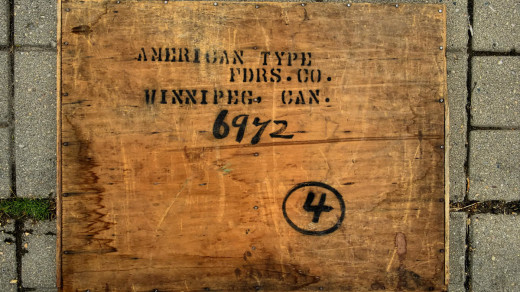
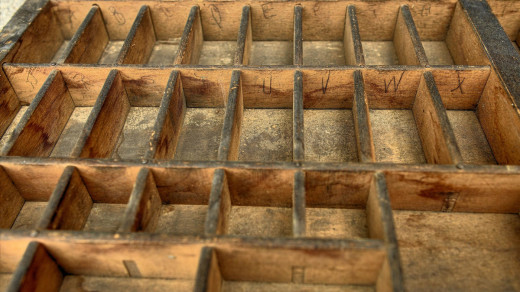
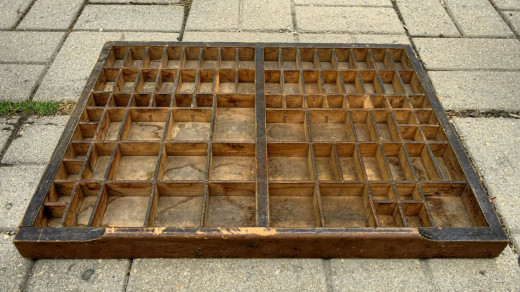
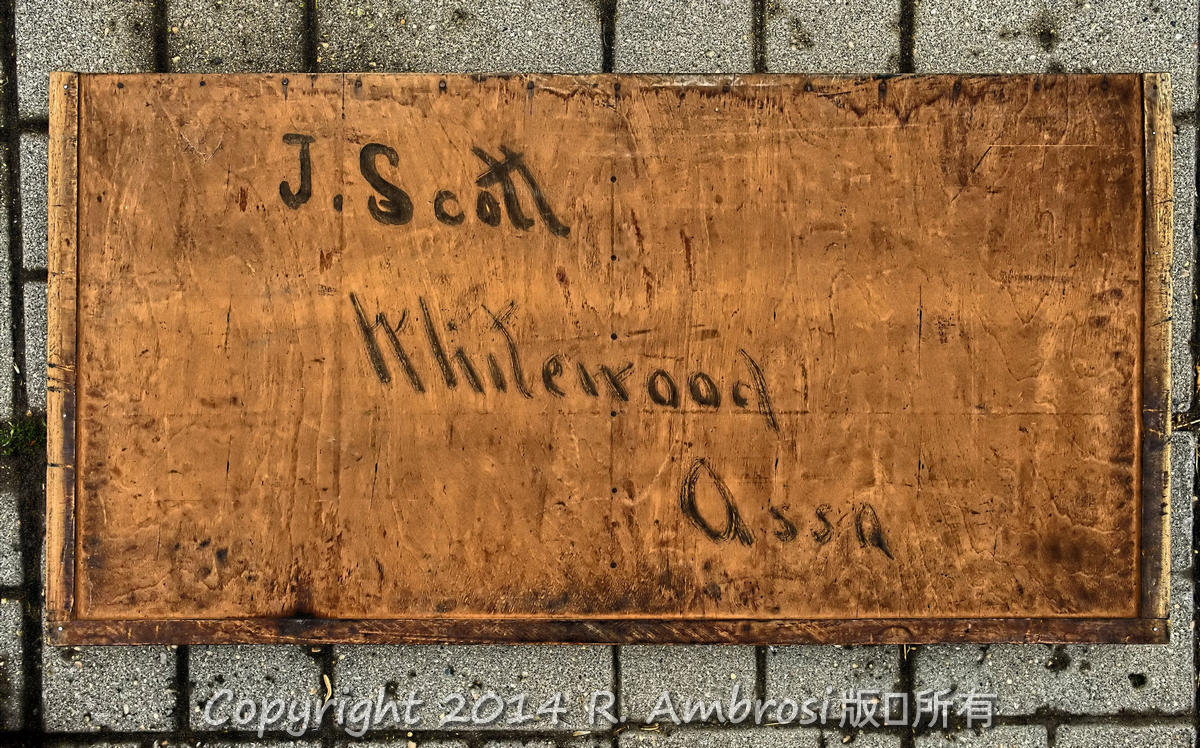
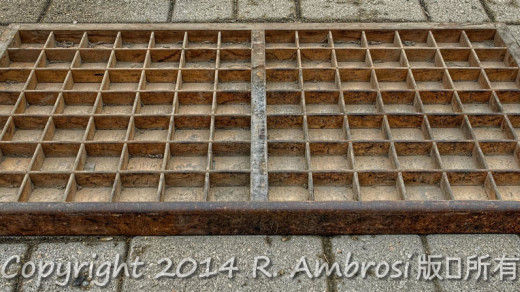
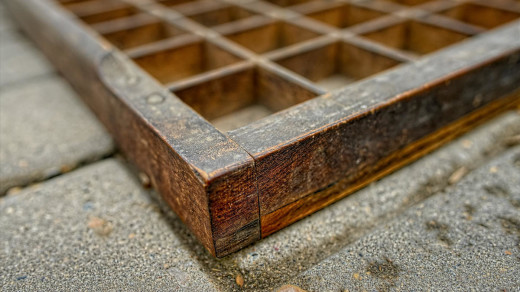
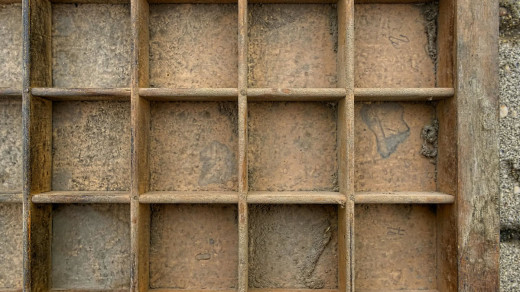
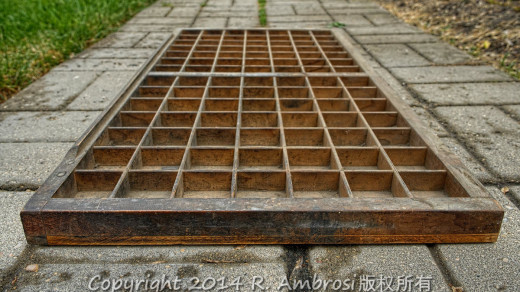
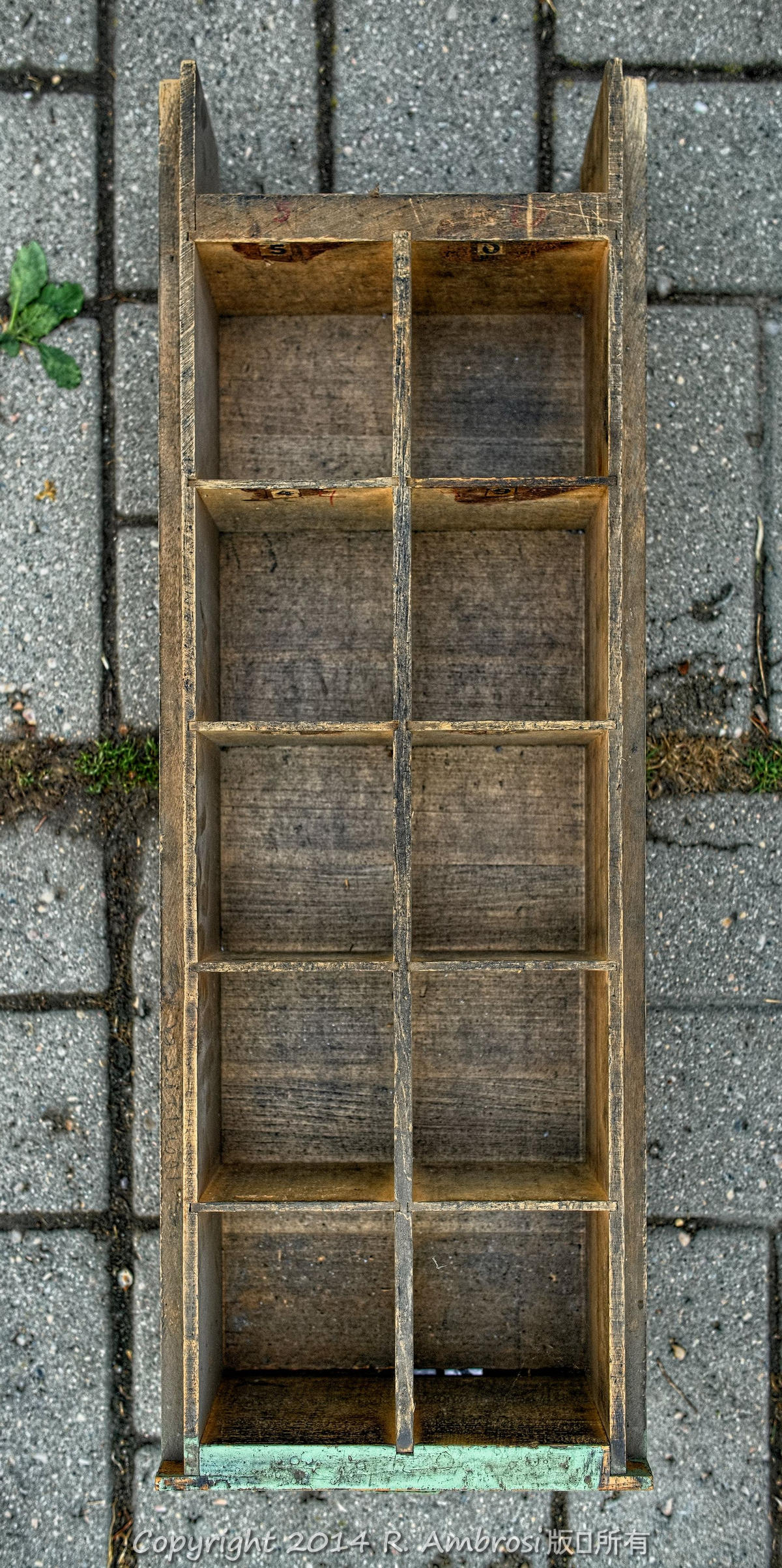
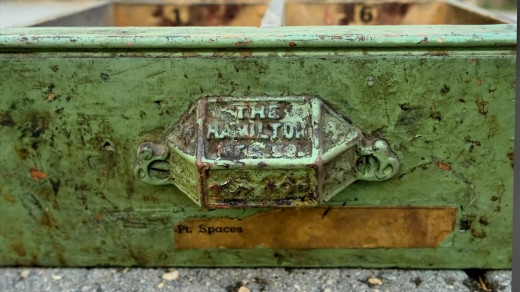
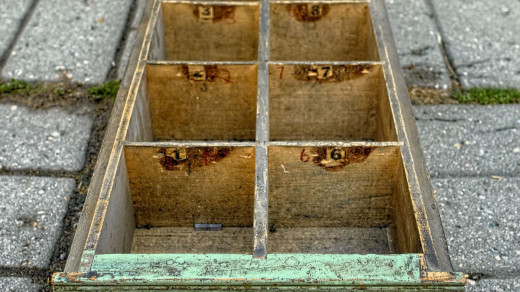
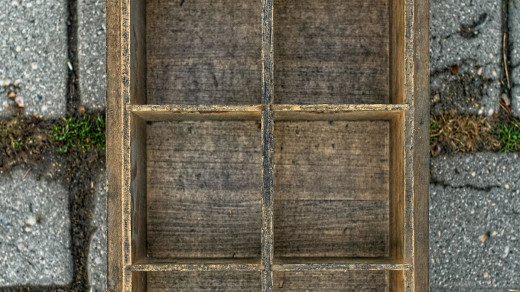
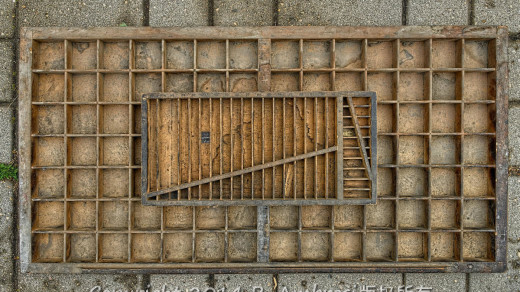
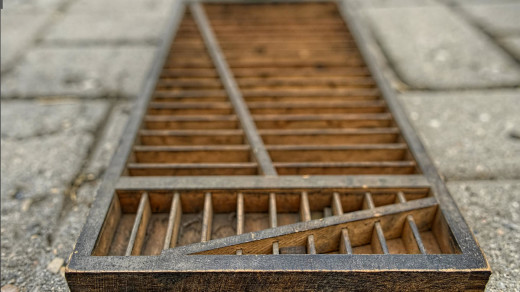
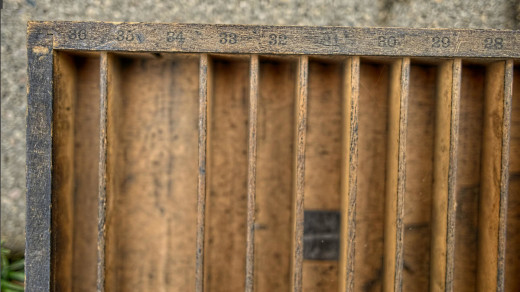
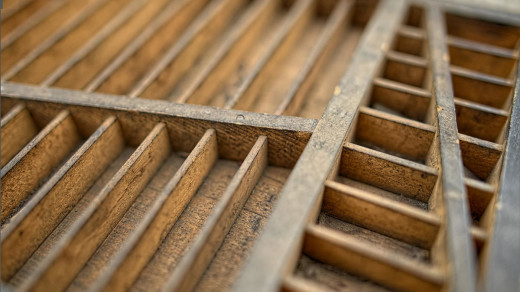
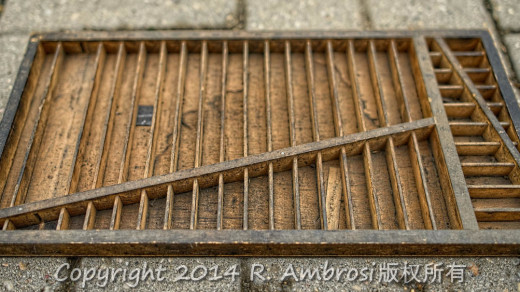
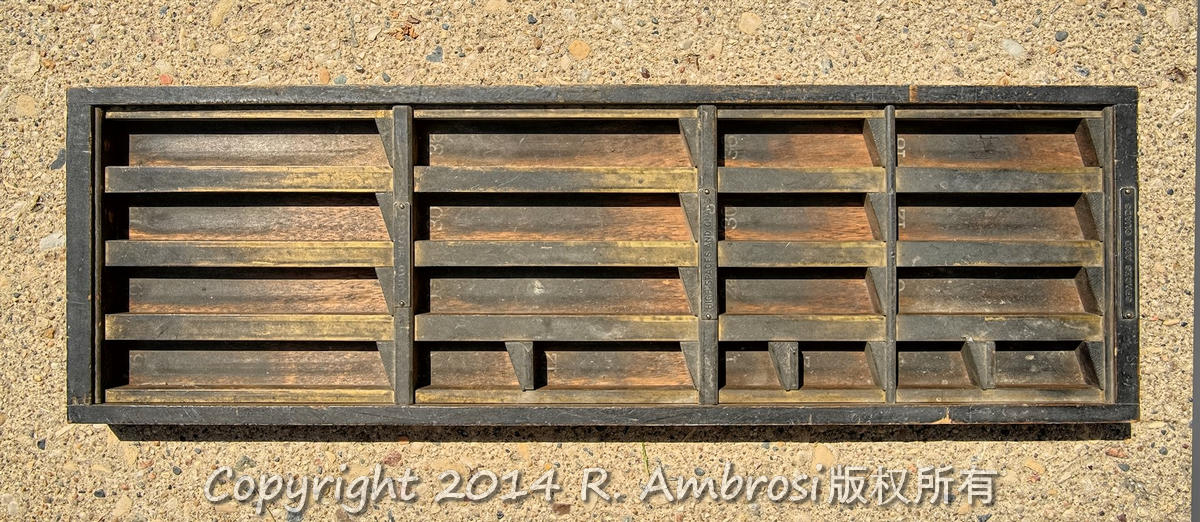
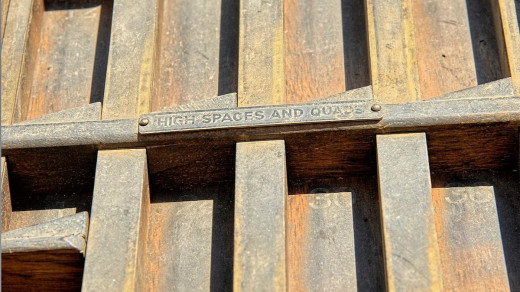
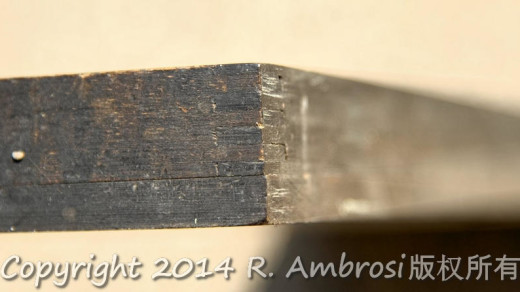
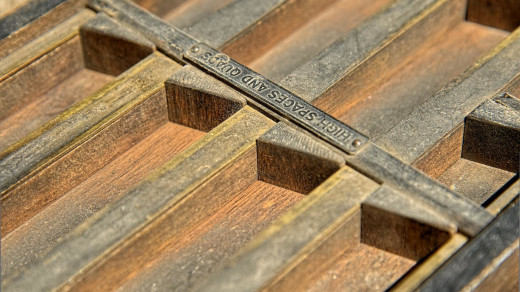
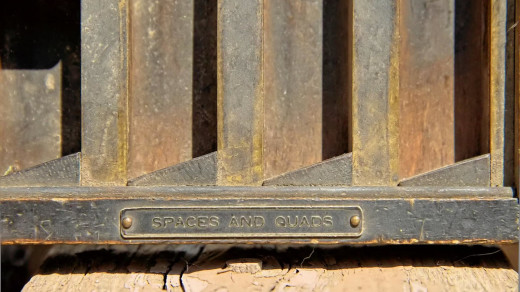
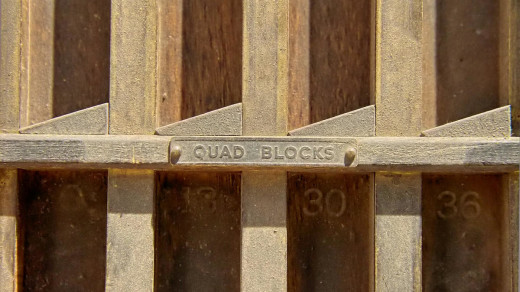
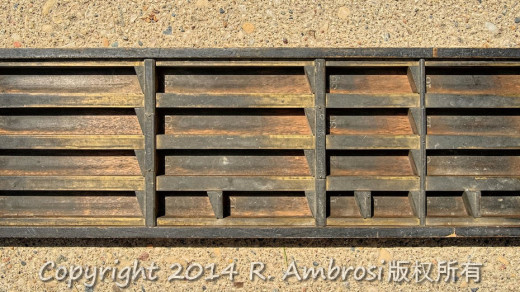
You must be logged in to post a comment.